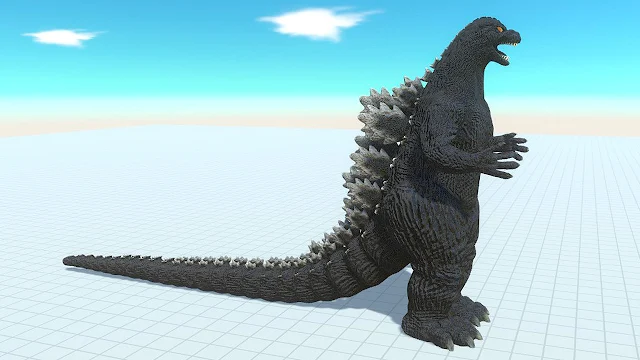- Get link
- X
- Other Apps
- Get link
- X
- Other Apps
Heisei Godzilla: A Comprehensive Guide to the Iconic Japanese Monster
Godzilla, the iconic Japanese monster, has been a household name for decades. He has appeared in various films and TV shows, captivating audiences with his monstrous form and unique abilities. Among the different iterations of Godzilla, the Heisei era (1984-1995) stands out as one of the most beloved by fans. In this article, we will delve into the world of Heisei Godzilla, exploring its history, design, and cultural impact.
History of Heisei Godzilla
The Heisei era marked the return of Godzilla to the big screen after a nine-year hiatus. The first Heisei Godzilla film, titled "The Return of Godzilla" (1984), served as a direct sequel to the original 1954 film. It was a darker and more serious take on the character, emphasizing the destructive nature of the monster rather than its heroism.
Subsequent Heisei Godzilla films, such as "Godzilla vs. Biollante" (1989) and "Godzilla vs. King Ghidorah" (1991), introduced new monsters and storylines, expanding the universe of the series. The Heisei era concluded with "Godzilla vs. Destoroyah" (1995), in which Godzilla's nuclear energy core is destabilized, leading to his eventual death.
Design of Heisei Godzilla
The design of Heisei Godzilla was a departure from the previous Showa era (1954-1975) designs. The Heisei Godzilla was more muscular and reptilian, with a longer tail and more defined scales. Its head was also redesigned, giving it a more menacing look with sharper teeth and a pronounced brow.
The Heisei Godzilla's appearance was influenced by the advancements in special effects technology and a desire to create a more realistic-looking monster. The suit used to bring Heisei Godzilla to life was also more advanced, allowing for greater mobility and expression.
Cultural Impact of Heisei Godzilla
Heisei Godzilla has had a significant cultural impact on Japan and the world. The films were critical and commercial successes, cementing the character's place in pop culture. Heisei Godzilla merchandise, such as action figures and clothing, continue to be popular among fans.
Beyond its entertainment value, Heisei Godzilla also represents a cultural commentary on Japan's post-World War II history. The character's nuclear origins reflect the traumas of the atomic bombings of Hiroshima and Nagasaki, as well as Japan's complex relationship with nuclear power.
FAQs
What is the origin of Godzilla?Godzilla was created in 1954 by Toho Company, Ltd. as a response to the atomic bombings of Hiroshima and Nagasaki.
How many Heisei Godzilla films were made?
How many Heisei Godzilla films were made?
There were seven Heisei Godzilla films made, spanning from 1984 to 1995.
Who played Godzilla in the Heisei films?
Who played Godzilla in the Heisei films?
Multiple actors played Godzilla in the Heisei films, including Kenpachiro Satsuma and Hurricane Ryu Hariken.
What makes Heisei Godzilla different from other versions of the character?
What makes Heisei Godzilla different from other versions of the character?
Heisei Godzilla is more muscular and reptilian in appearance, with a longer tail and more defined scales. Its head was also redesigned, giving it a more menacing look with sharper teeth and a pronounced brow.
What is the cultural significance of Heisei Godzilla?
What is the cultural significance of Heisei Godzilla?
Heisei Godzilla represents a cultural commentary on Japan's post-World War II history, reflecting the traumas of the atomic bombings of Hiroshima and Nagasaki, as well as Japan's complex relationship with nuclear power.
Conclusion
Heisei Godzilla is a fascinating and iconic character that has captured the imag
Is Heisei Godzilla the strongest Godzilla?
The strength of Godzilla varies across different movies and storylines, and it is difficult to determine definitively which version is the strongest. However, it is worth noting that Heisei Godzilla was depicted as being more powerful and durable than previous iterations, able to withstand attacks from other monsters and even survive a nuclear meltdown.Is Heisei Godzilla a villain?
In some of the Heisei era Godzilla movies, he is portrayed as a villain, while in others he is more of an anti-hero or even a protagonist. The depiction of Godzilla in the Heisei era varied depending on the story and the movie's creative direction. In some movies, he was a destructive force that needed to be stopped, while in others he was a defender of humanity against other monsters.Is Heisei Godzilla stronger than legendary Godzilla?
It is difficult to compare the strength of Heisei Godzilla and Legendary Godzilla directly since they exist in different movie universes and have different abilities and weaknesses. Legendary Godzilla, for example, is much larger than Heisei Godzilla and has more powerful atomic breath. On the other hand, Heisei Godzilla is more agile and has displayed impressive regeneration abilities. Ultimately, it comes down to personal interpretation and preference as to which Godzilla is considered stronger.
- Get link
- X
- Other Apps

Comments
Post a Comment